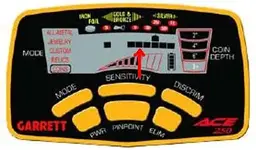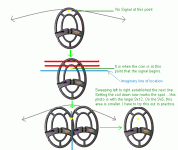Ricardo_NY1
Bronze Member
- #1
Thread Owner
For those interested or who down the road get a 250, just wanted to let you know that the technique for X'ing which I outlined in the photos in this post worked almost flawlessly for me last night. This is something that I developed in my living room and could not verify until I actually tried it last night for about 3 hours.........the verdict......I went from digging huge holes to getting the accuracy I had developed with my former metal detector. I was dead on. Now I feel good with my ACE 250. Also, I will write a seperate and new topic today regarding bottle caps. All ACE 250 users might be interested in reading this.
I just started using this detector about 3 days ago and I am impressed with its depth capabilities already, however, please let me hear your input on the following...........
1. "X'ing", let's forget about pin-pointing, I'm talking about good 'ol manual X'ing. X'ing has proven very, very tricky. Only yesterday did I learn that the signal is given off on the outer sides of the coil. In other words, on a left sweep, you hear the beep when the right edge of the coil passes and vice versa. With the BH 1100 style, I started X'ing with good accuracy, with the 250 I am kind of all over the place. Advice, tips, even how long it took you to get used to manual X'ing with this different system would be appreciated here. I could seriously do without a pin-pointer as I did with the BH 1100, but only if my X'ing is as accurate as I got it with that detector. Pin-pointing with the 250 is a subject all to its own. I personally would rather learn a detector to the point where I have the X'ing down packed before I go onto and relying on pin-pointing with a PPointer.
2. Discrimination. So far it is bottle cap thirsty. I found a somewhat compromising fix to the bottle caps by eliminating the notch that is indicated by the red arrow in the attached photo, however, by eliminating that notch, I can get a signal on a 1980 and new 2006 penny, but not a wheatie. I'll have to pass on the wheaties with this 250, as there are just to many caps out there........what irks me a bit is that my BH 1100 had no issue disc'ing these caps out in its simple Disc modes.....I actually took some of these caps home and the BH eliminated them fine while picking up a wheatie. Can anyone here elaborate on this?
Are there other detectors out there that employ the outer edge signal like the ACE 250? The BH 1100 that I was using sounded off when the object passed near center, and this seems logical and the learning curve for X'ing was a whole lot easier.
I just started using this detector about 3 days ago and I am impressed with its depth capabilities already, however, please let me hear your input on the following...........
1. "X'ing", let's forget about pin-pointing, I'm talking about good 'ol manual X'ing. X'ing has proven very, very tricky. Only yesterday did I learn that the signal is given off on the outer sides of the coil. In other words, on a left sweep, you hear the beep when the right edge of the coil passes and vice versa. With the BH 1100 style, I started X'ing with good accuracy, with the 250 I am kind of all over the place. Advice, tips, even how long it took you to get used to manual X'ing with this different system would be appreciated here. I could seriously do without a pin-pointer as I did with the BH 1100, but only if my X'ing is as accurate as I got it with that detector. Pin-pointing with the 250 is a subject all to its own. I personally would rather learn a detector to the point where I have the X'ing down packed before I go onto and relying on pin-pointing with a PPointer.
2. Discrimination. So far it is bottle cap thirsty. I found a somewhat compromising fix to the bottle caps by eliminating the notch that is indicated by the red arrow in the attached photo, however, by eliminating that notch, I can get a signal on a 1980 and new 2006 penny, but not a wheatie. I'll have to pass on the wheaties with this 250, as there are just to many caps out there........what irks me a bit is that my BH 1100 had no issue disc'ing these caps out in its simple Disc modes.....I actually took some of these caps home and the BH eliminated them fine while picking up a wheatie. Can anyone here elaborate on this?
Are there other detectors out there that employ the outer edge signal like the ACE 250? The BH 1100 that I was using sounded off when the object passed near center, and this seems logical and the learning curve for X'ing was a whole lot easier.







